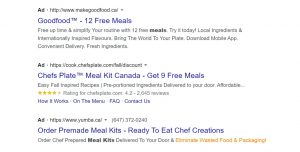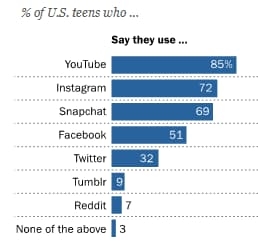— January 11, 2019
So, you want to start a blog for your small business? Great idea! Although, there are a few things you need to know before you do.
Today, I’d like to give you a comprehensive guide detailing everything you will need to do to create a mind-boggling small business blog.
Small Businesses Need Blogging to Grow
Blogging is becoming essential among small businesses. In fact, according to HubSpot’s 2018 inbound marketing report, 55% of marketers say, “blog content creation is their top inbound marketing priority.” In addition, businesses who blogged on average between 11-16 times a month saw 3-3.5 times more traffic and 4-4.5 more lead generation than businesses who posted less regularly.
It’s no secret: small businesses have a lot on their plate as is. It’s hard to find time to blog. Between trying to keep the business afloat to keeping up with online marketing, small businesses struggle with finding time for additional responsibilities. Why, then, should a small business still go ahead and start a blog?

Blogging to Get Noticed
As mentioned earlier, blogging has become bigger than ever before. In fact, according to WordPress, over 409 million people view blog posts every month. With more audience showing interest, it has become the perfect platform to build awareness around your businesses’ brand.
Humanize Your Company by Blogging
Conventional wisdom follows: the “about us” page gives users insight into your business; however, a blog humanizes your company. On a blog, you are able to zero in on areas of interest facing your business. You also get to share your brands’ voice and personality with audiences and, in the process, build trust, increasing your like-ability quotient.
Gain Insights From Your Blog
The only way for your business to survive in the digital space is to keep customers engaged but there are only so many ways to do it—one way is through is blogging. Blogging gives your business an opportunity to connect with both your existing customers and prospects through posting and commenting. It removes the veil between you and your customers, creating a favorable position for your business to gain new insights and dialog. Your customers also get an opportunity to ask you questions directly about your products and give valuable feedback about what they think.
Blogging Drives Traffic to Your Website
There are many reasons why it is paramount to have a business blog, but one of the most important reasons is it drives traffic to your website. Businesses that prioritize blogging are 55% more likely to receive traffic than businesses without a blog. Yes, it takes up a large chunk of your time; however, putting in the time can create huge payoffs down the road, especially if you are looking to organically attract new customers.
Use Blogs to Improve Your Website Ranking
Websites with a blog tend to have 434 per cent more indexed pages, which means those websites have an improved 434 per cent chance to be seen ahead of websites without blogs. Improving your website’s ranking in search results is as easy as creating a consistent blog because consistent blogging increases the visibility of your keywords, which translates into more exposure and clicks.
7 Important Thoughts for a Small Business Blog
Why are you creating a blog?
Before you start a blog, you need to establish why you need one in the first place. Understanding how a blog can help you to achieve your business goals is the first thing to consider. Once you have that outlined, consider the benefits you expect to reap from having a blog.
Who is your target audience?
Once you have defined why you are creating a blog, you probably expect to begin writing, but it’s more multifaceted than you might first imagine. The next step is to identify your target audience. You want to define your target audience, so you know which topics will create the highest impact and which marketing channels you’ll need to use to have the best reach; otherwise, you’ll invest all your time and effort writing material no one is excited to read. This will only serve to be counter-intuitive to your marketing efforts.
What are you going to blog about?
Before you start writing, you need to brainstorm content ideas. What is it that you want to write? What kinds of topics do you think might excite your audience? Are the topics you’re thinking of writing in line with what you’re selling? This brainstorming process helps you come up with content that’s relevant to your audience. When your audience feels something is relevant to their needs, it’s easier for them to buy into your ideas.
How frequently are you going to be posting content?
When it comes to blogging, consistency is key. You don’t have to churn out posts every day, but it’s important to ensure you are in your audiences’ feeds as much as you can be. It’s completely fine if you don’t have inspiration for a couple of days, but don’t post a bunch of articles in one week and then go completely off the radar for months. If you do, your blog may lose those viewers you worked so hard to get.
How do you intend to market your blog?
Once you have a blog you’re happy with, it’s time to start getting readers’ eyes on it. The next step is to determine which channel you want to market your blog through. In the beginning, you’ll need to experiment. The channel you select should fit with to your business’ needs, so encourage members of your staff to get involved and brainstorm how to find traffic sources for your blog.
Budget your time
Traditional budgets allocate for expenses; however, for a blog, it’s more so an investment in time. You are easily looking at hours of writing over the long term. Sometimes, putting aside time for blog writing when there are dozens of other competing responsibilities can be a challenge, so you’ll need a game plan of how you’ll find time to write your blog and still tackle all your other tasks. What you need is a time budget.
But it doesn’t stop there. Once you’ve published the blog, you’ll also need to spend time marketing your content; otherwise, your audience may not know it’s there. Without marketing your content, you’ll be passing up a great opportunity to attract readers. Now, this doesn’t mean readers might not still bump into your content one way or another. However, it’s incredibly important to give them a nudge in the right direction, so they find it much sooner. This means that you’ll have to take more hours out of your day to market the content.
How does blogging fit into your other marketing efforts?
There’s one last consideration you need to make. It’s especially important because it ties to the bigger picture of your business processes. You need to provide practical value to your readers in your blog posts in order to successfully promote your blog as a resource you can send to subscribers through email or social media.
Tips for Conquering a Small Business Blog
Conduct keyword research
You already know what you’re going to cover in your blog. That’s great! Now, you need to align it with what people are searching for. To be able to hone in on the right keywords, you need to do thorough research and incorporate some popular keywords, which aren’t too competitive, into your title and throughout your blog. Look to use keyword phrases in conjunction with plain keywords.
Aim for optimized blog lengths
It’s a topic that stirs up a lot of conversations. How lengthy should your blog post be? What is the ideal word count for a blog? It’s a valid question. Here’s the rub: the word count only matters if you have written high-quality content. Even if you write a 20,000-word blog post, but it possesses poor quality, it won’t change the outcome. However, if the content is quality, blog posts of a 1000 words and up typically get the most shares. Although, you will be hard pressed to determine what the ideal word count is, one thing is for sure: long-form content is better than short-form content.
Incorporate visuals
No matter how great your content is, it takes a lot more than great content to stimulate an audience. Statistically, 65% of people are visual learners and about 90% of the information the brain receives is visual information. Furthermore, visuals make it easier to remember content and are far more likely to go viral.
Address customer queries
Another tactic is to ensure you make your customers feel valued. One of the best ways to do that is by addressing customer queries on a specific blog topic. It helps to put you in good standing with your customers while creating actionable content, keeping readers engaged.
Invite other bloggers to guest post on your blog
Guest posting is a great way to increase your website’s page rank. The benefits don’t stop there. For starters, it will save you a lot of the time you would have spent writing a blog post yourself. Secondly, inviting a guest blogger helps give your blog a fresh voice and a fresh outlook on topics, which can be exciting to your readers. Lastly, those who you ask to guest post will in-turn ask you to guest post for them, as reciprocity is commonly understood to be mutually beneficial among bloggers.
Blogging is Easy; Successful Blogging is Hard
Starting a blog is easy. Anyone can do it. Creating a successful blog, however, is far harder. It takes an ample amount of work and dedication. If you’re serious about starting a successful small business blog, remember: determine how your blog can support your larger business objectives. From there, find your audience, your brand’s voice, and provide useful content you can market.
Digital & Social Articles on Business 2 Community
(74)






